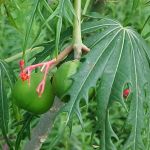| Common Name: |
Purging Nut |
| Other Names: |
Physic Nut, Barbados Nut |
| Botanical Name: |
Jatropha curcas |
| Genus: |
Jatropha |
| Family: |
Euphorbiaceae |
| Native Location: |
Tropical America |
| Cultivation: |
Sharply drained, rich soil in sun. |
| Propagation: |
By seed sown when ripe at 24°C (75°F); by stem-tip cuttings in spring and summer. |
| Harvest: |
Seeds are collected when ripe and used whole or pressed for oil. Leaves, roots, and bark are collected as required and used fresh in decoctions and poultices. Juice (latex) from stems is used fresh or dried into a brittle brown substance. |
| Height: |
6m (20ft) |
| Hardiness: |
Z10 |
| Parts Used: |
Seeds, oil, latex, leaves, roots. |
| Properties: |
A strongly purgative, irritant, antiseptic herb taht controls bleeding. |
| Medicinal Uses: |
Internally in carefully measured doses, and externally in the form of an enema or rubbing oil, as a purgative (seeds, leaves, bark). Internally for paralysis and intestinal worms. Externally for wounds, skin diseases, rheumatism, gum boils, ant to control bleeding and produce an airtight film over broken or festering skin (latex); also as a poultice to increase lactation (leaves). |
| Economic Uses: |
Oil is used in the manufacture of soaps and candles, and in oil lamps. |
| Warning: |
All parts contain a milky latex that may irritate the skin and mucous membranes. |
| Bibliography: |
Encylopedia of Herbs by Deni Brown Copyright ©: 1995, 2001 Dorling Kindersley Limited pp 246-247
|

